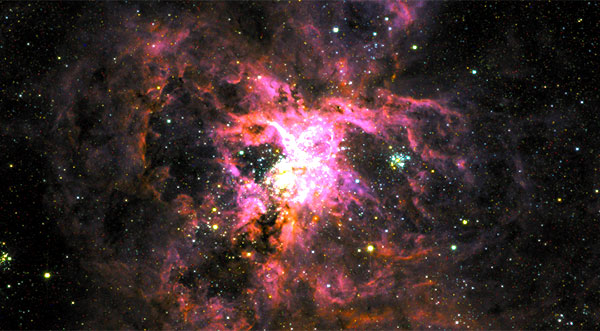NASA & SPACE NEWS

(NASA) – The Super Pressure Balloon Imaging Telescope that launched on a scientific super pressure balloon captured its first research images from this flight of the Tarantula Nebula and Antennae Galaxies.
These images were captured on a balloon-borne telescope floating at 108,000 feet above Earth’s surface, allowing scientists to view these scientific targets from a balloon platform in a near-space environment.
The advantage of balloon-based versus space telescopes is the reduced cost of not having to launch a large telescope on a rocket. A super-pressure balloon can circumnavigate the globe for up to 100 days to gather scientific data.
The balloon also floats at an altitude above most of the Earth’s atmosphere, making it suitable for many astronomical observations.
The SuperBIT telescope captures images of galaxies in the visible-to-near ultraviolet light spectrum, which is within the Hubble Space Telescope’s capabilities, but with a wider field of view.
The goal of the mission is to map dark matter around galaxy clusters by measuring the way these massive objects warp the space around them, also called “weak gravitational lensing.”
The Antennae Galaxies as seen by SuperBIT. The nebula is a slightly transparent, light blue mass in the middle of the image. The mass is divided into two lobes, shaped like teardrops.
The upper lobe has a spiral of light blue and yellow in its center. Extending straight up and down from the two lobes are two thin tails of gas and dust, which look like antennae.
The nebula is on the backdrop of black space, dotted with white and blue stars. The largest stars, one in the upper right and one in the lower left, each have four diffraction spikes.

The Antennae galaxies, cataloged as NGC 4038 and NGC 4039, are two large galaxies colliding 60 million light-years away toward the southerly constellation Corvus.
The galaxies have previously been captured by the Hubble Space Telescope, Chandra X-ray Observatory, and the now-retired Spitzer Space Telescope. A composite image of the galaxies combines data taken by all three telescopes.
SuperBIT’s first research images from this flight were released by Durham University here. The SuperBIT team is a collaboration among NASA; Durham University, United Kingdom; the University of Toronto, Canada; and Princeton University in New Jersey.
CLICK HERE FOR BREVARD COUNTY NEWS
The post NASA’s Super Pressure Balloon Imaging Telescope Captures First Research Images appeared first on Space Coast Daily.

